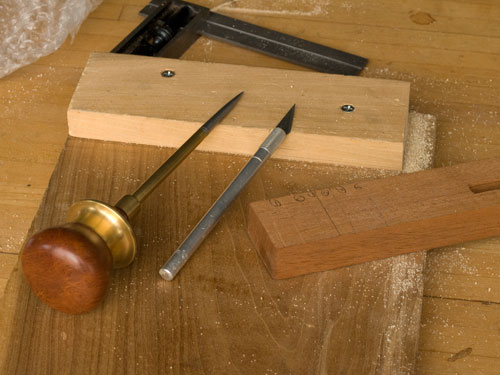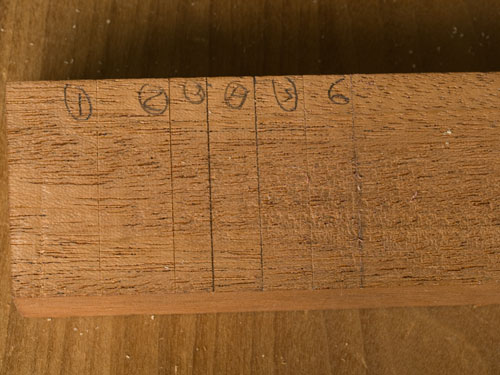 I just read Rob Lee's post on comparing a marking knife with an awl and I realized that lots of folks miss out on a great feature of a properly unsharpened awl. I just read Rob Lee's post on comparing a marking knife with an awl and I realized that lots of folks miss out on a great feature of a properly unsharpened awl.
We are so used to getting super-sharp tools and cutting nice and deep that we forget that in most cases any remaining knife line in the wood - especially if it cuts fibers - will have to be deeply planed out or it will catch finish and leave an ugly line.
Charles H. Hayward said that in the old days (19th century), one tried to not have excess scribe lines, but by the time he apprenticed (c. 1910) more lines were left in.
If your awl is slightly dull - and I mean just slightly dull - it will make a nice precise dent in the wood, it won't catch grain and wander, and it will be shallow enough to easily remove. And of course it still be deep and sharp enough to catch a chisel edge or any other marker.
 Even if you use a knife to mark, a shallow cut can be hard to see. Running a sharp pencil in the line (hold the pencil at a low angle) will make the line easier to see. For a finer line, erase the pencil line by going back and forth over the line with an eraser. A tiny bit of lead will still remain in the scribe line so you can see it. Even if you use a knife to mark, a shallow cut can be hard to see. Running a sharp pencil in the line (hold the pencil at a low angle) will make the line easier to see. For a finer line, erase the pencil line by going back and forth over the line with an eraser. A tiny bit of lead will still remain in the scribe line so you can see it.
Here are 6 lines we made for comparison:
1 - An awl line.
2 - A line cut with an Exacto knife (one that I have had for 25 years) with a brand new, extremely sharp blade.
3 - Exacto blade enhanced with pencil.
4 - Awl line enhanced with pencil.
5 - Awl line enhanced with pencil, with excess erased.
6 - Exacto line enhanced with pencil, with excess erased.
I'm not sure the picture exactly does the lines justice, but on the actual piece of wood all the lines are pretty clean and easy to see (the ones with the pencil are definitely easiest). The knife lines are fine, but a little deeper, and you'll have to take care with that depth of mark.
The same theory - a slightly dull pin won't catch the grain quite so much - should be used to make a mortise or marking gauge behave.
Try it for yourself and let me know if you agree.
|
 Joel's Blog
Joel's Blog Built-It Blog
Built-It Blog Video Roundup
Video Roundup Classes & Events
Classes & Events Work Magazine
Work Magazine


 I just read
I just read  Even if you use a knife to mark, a shallow cut can be hard to see. Running a sharp pencil in the line (hold the pencil at a low angle) will make the line easier to see. For a finer line, erase the pencil line by going back and forth over the line with an eraser. A tiny bit of lead will still remain in the scribe line so you can see it.
Even if you use a knife to mark, a shallow cut can be hard to see. Running a sharp pencil in the line (hold the pencil at a low angle) will make the line easier to see. For a finer line, erase the pencil line by going back and forth over the line with an eraser. A tiny bit of lead will still remain in the scribe line so you can see it.
I noticed that my marking and mortise guages work better with a slightly dull pin. I sharpen them then take off the real sharp point and it tracks better. It seems that the sharp points want to follow the grain, whereas the almost sharp points follow the fence.
A slitting or cutting gauge with a sharp knife requires great care not to follow the grain of the wood. If possible I use a marking gauge to give me a working score line, but the sharp edge will still follow the grain.
Stephen
For cross grain work I favor a knife line, so line 2 in your sample looks good to me.
For work along the grain, I do not like a knife line because when marking it tends to deflect with the grain direction and I can't see it. A scribe point works well for me. For hard dense light colored woods, like hard maple, I like a fine point.
For some other species and situations, yeah, I think a bit duller point is better. Scribing mortise lines is a good example. I enhance the gauge lines with a pencil. The pencil darkens the walls of the little gully left by the marking point which makes it easy to saw to the clear central vein of the scribing.
One other thought: when transferring the tail outlines to the endgrain of the pin board, I just cannot see knife lines, especially in fine diffuse porous wood like cherry or maple. There a fine scriber works best for me, again taking advantage of sighting that central gully in the scribed line.
So much of this depends on visual preferences. These little subtleties of woodworking are well worth exploring; thanks for the post.
Rob